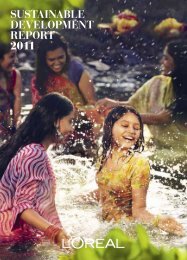Organizational Strategy - Sustainable Development - L'Oréal
Organizational Strategy - Sustainable Development - L'Oréal
Organizational Strategy - Sustainable Development - L'Oréal
Create successful ePaper yourself
Turn your PDF publications into a flip-book with our unique Google optimized e-Paper software.
6 L’oréaL - GrI DaTa SHEETS 2011<br />
TRANSPORT<br />
L’oréal optimises its global production on a regional basis, placing operations teams as close as possible to the markets they serve. This<br />
allows each production site to be more responsive and more efficient in terms of logistics and transport.<br />
While, relatively speaking, greenhouse gas emissions in the cosmetics industry is limited, transport still contributes to L’oréal’s overall<br />
carbon footprint.<br />
L’oréal’s logistics network moves over 5.78 billion products a year from factories to distribution centres to the customers all over the world.<br />
NEW CARBON REDUCTION INITIATIVES<br />
road transport represents 58% of the means of transport used by L’oréal. as far as possible, the logistics teams use greener forms of<br />
transport that enable the group to meet required costs and deadlines. In 2011, L’oréal has placed priority on other methods and different<br />
modes of transport with lower greenhouse gas emissions.<br />
> For more details, see page 24 of the <strong>Sustainable</strong> <strong>Development</strong> report 2011.<br />
BIODIVERSITY<br />
In 2010, the signatory countries to the Convention on Biological Diversity approved the Nagoya Protocol, aimed at regulating access to<br />
resources in a given territory and the fair sharing of benefits resulting from those resources. L’oréal research was aware of these issues well<br />
before the protocol came into effect, and since 2005 has continuously striven to secure its supply chains so that they meet the issues of<br />
sustainable development.<br />
This awareness goes hand in hand with the increasing use of renewable plant-based ingredients in their products, as with Biotherm which<br />
launched a men’s deodorant with 100% natural ingredients this year. Palm oil supply is a significant example: in 2011, L’oréal’s was again<br />
recognised as sustainable by the WWF with a score of 9/9 on their rating scale. Similarly, the group’s argan sourcing was the subject of<br />
a presentation by an external expert, Daniel robinson (New South Wales University, australia), during the “Union for Ethical BioTrade”<br />
conference, where it was hailed as a proactive initiative for “accessing and sharing benefits”.<br />
SUMMARY OF THE ENVIRONMENTAL PERFORMANCE OF FACTORIES AND DISTRIBUTION CENTRES OF THE L’ORÉAL GROUP<br />
• Increase of 15.8% in manufacturing capacity (2005-2011) 4.<br />
• Emissions of greenhouse gases: absolute reduction of 29.8% (tonnes of Co 2 , direct and indirect 2005-11) 4.<br />
• reduction in water consumption of 22.6% (litres per finished product, 2005-11) 4.<br />
• reduction of 24.2% in production of transportable waste (grams per finished product, excluding returnable packaging, in the factories<br />
and distribution centres, 2005-11) 4.<br />
ENERGY<br />
I. CONTENTS<br />
CORE<br />
ADD<br />
EN3<br />
Direct energy consumption by primary<br />
energy source.<br />
EN4<br />
Indirect energy consumption by primary<br />
source.<br />
EN5<br />
Energy saved due to conservation<br />
and efficiency improvements.<br />
2/12<br />
ADD<br />
EN6<br />
Initiatives to provide energy-efficient<br />
or renewable energy based products<br />
and services, and reductions in energy<br />
requirements as a result of these initiatives.






